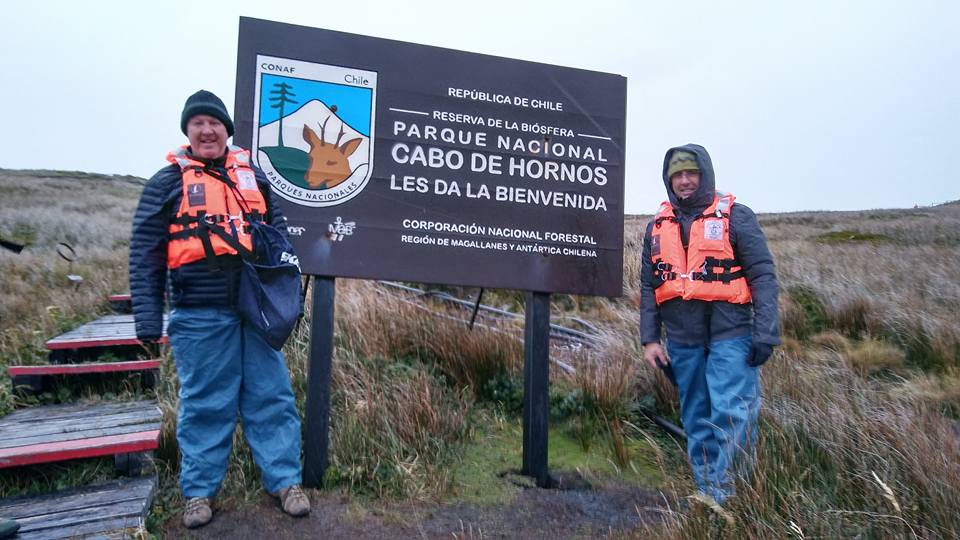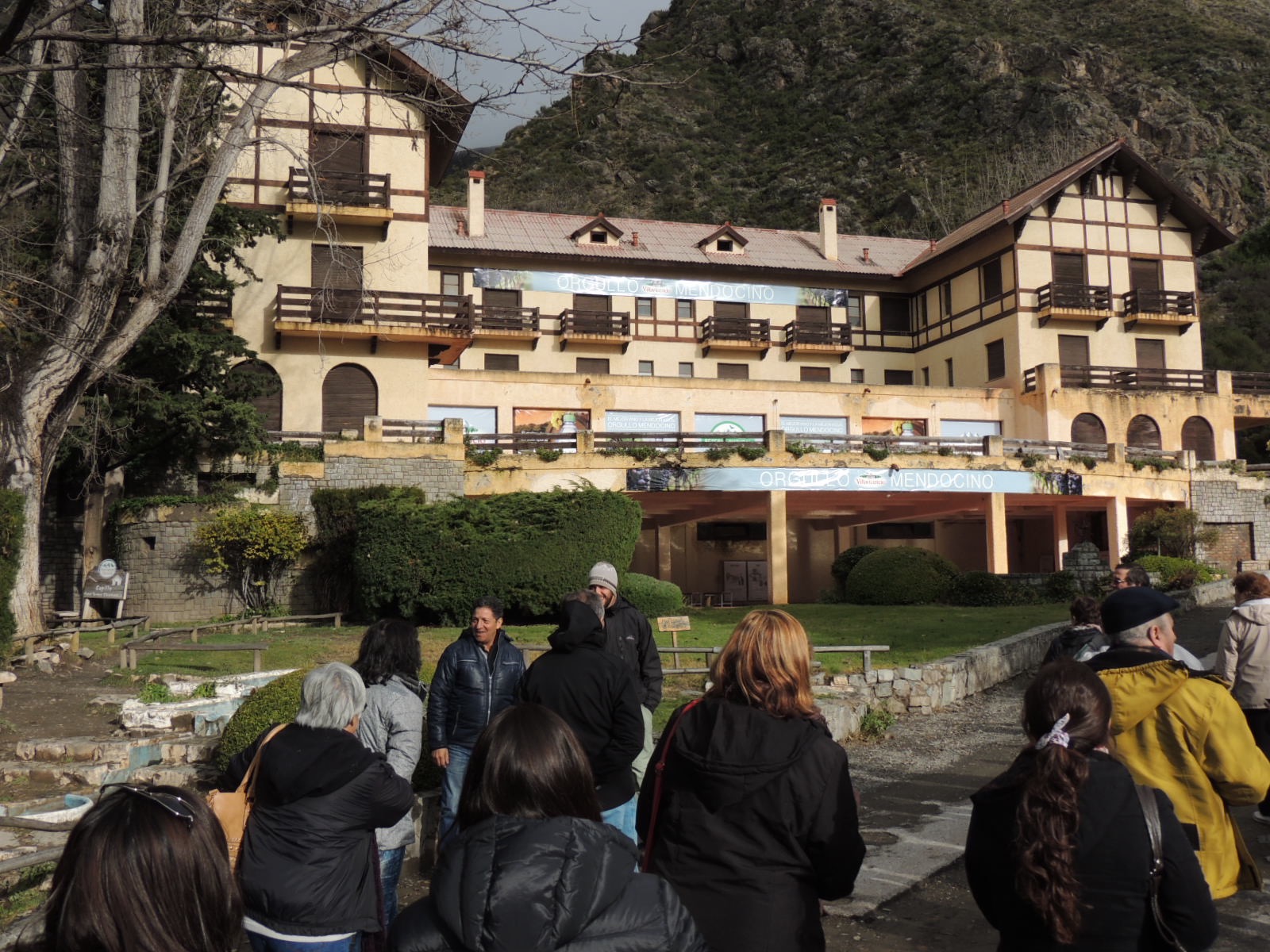What is your image of Buenos Aires? Swirling dancers melted together while dancing tango? Evita waving from the balcony of the Casa Rosada?
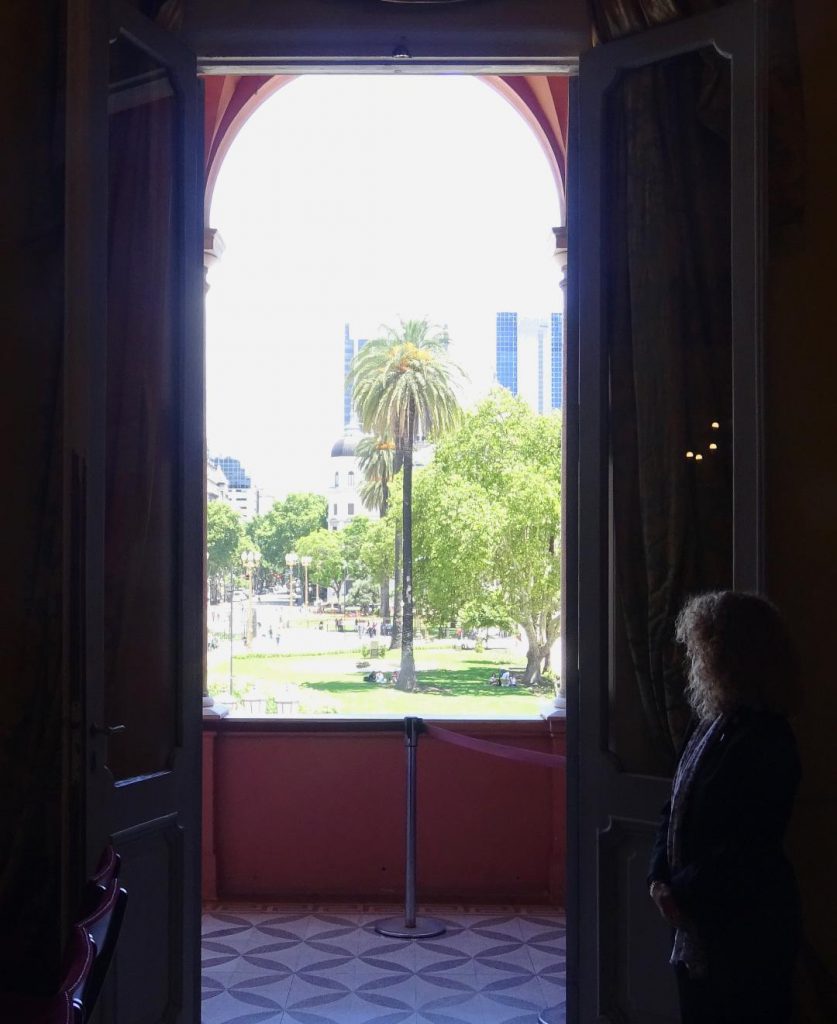
The Casa Rosada balcony
Juicy steaks roasting on an asado grill? Grand boulevards with a Parisian feel? And what’s the deal with an economy where the Argentine peso’s value fluctuates so widely most everybody would prefer your dollars—which stretch very far these days?
Argentina’s shimmering capital covers 80 square miles—Manhattan is only 24—and there are 48 distinct neighborhoods called “barrios.” Confused by all the possibilities, we hired Patricia (along with a driver) for a historical and practical overview. While independent travelers often scoff at hiring a guide, her insights into the complex political issues, the citizens’ love/hate relationship with Evita, warnings to avoid the subways and which taxis are safe, were invaluable. We could never have navigated the crowded Recoleta cemetery—more magical than macabre—or heard the fascinating stories behind the facades. Yes, Evita is buried here—give meters down to prevent looters—in the relatively modest Duarte family tomb. Far more poignant was the statue of Liliana—who died in an avalanche on her honeymoon—and her faithful dog.
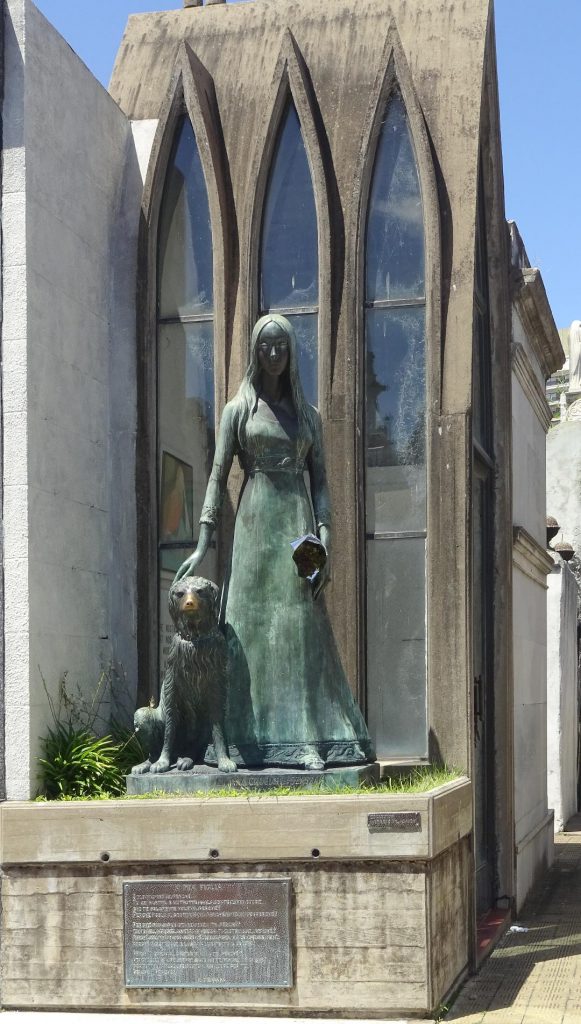
The tomb of Liliana, who died in an avalanche on her honeymoon along with her faithful dog. Her grave is in Recoleta Cemetery.
With advance planning, you can sign for a free guided tour of the Casa Rosada (the Pink House), the seat of the Argentine government.
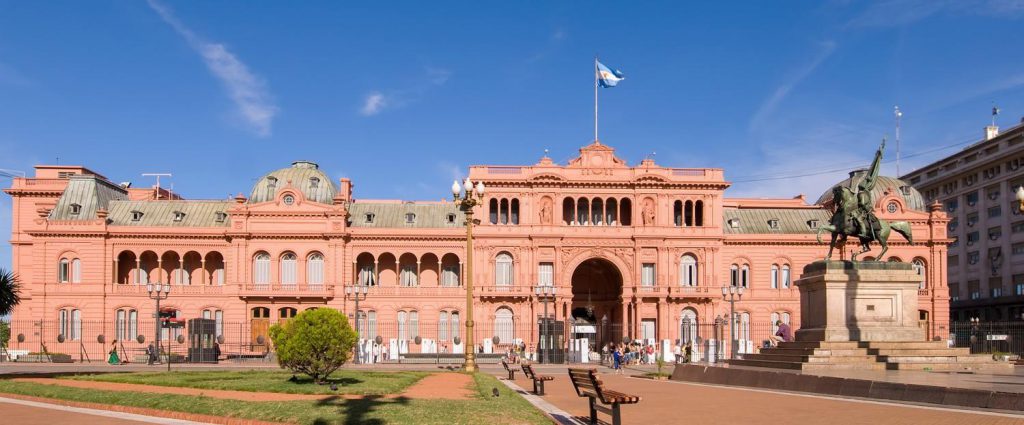
The famous Casa Rosada, home to the current president of Argentina
Not only can you walk through the president and vice-president’s offices, you can stand on the famous balcony overlooking the Plaza de Mayo, wave to the imaginary crowd, and pretend—for a moment—that you are the head of state.
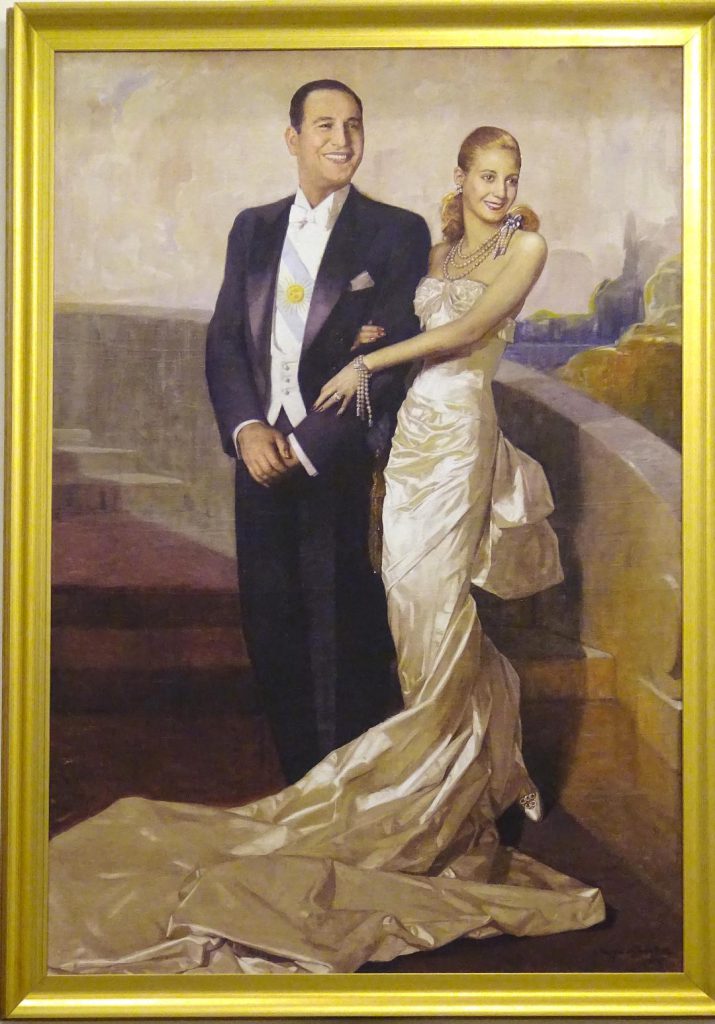
Evita and Juan Peron’s Portrait in the Casa Rosada, Pink Palace
Tours in English are available on Saturdays, Sundays and public holidays and you need to book ahead and give ID and passport information online.
The second day we felt confident to explore some of the unique barrios on our own. La Boca—the birthplace of tango—is colorful in the extreme with brightly hued houses, murals, street artists and musicians, empanada stands, and kitschy fridge-magnet wares.

La Boca District Facade
We had been warned not to wander from El Caminito, the main cobblestone strip to avoid pickpockets.
Since it was Sunday, we headed to one of the best antique markets in the world in San Telmo’s Plaza Dorrego. Our first feeling was sadness since it seemed as if everyone was selling family heirlooms in this depressed economy. Fine crystal, silverware, jewelry, rare records and books and—if you collect seltzer bottles—amazing arrays of colorful spritzers—were on offer at reasonable prices.
We could have spent a month seeing a different museum every day, but the top of our list was the Museo de Arte Latinoamericano de Buenos Aires (MALBA) with works by Diego Rivera, Frida Kahlo (“Self-Portrait with Monkey and Parrot”) and Fernando Botero in the permanent collection of Latin America artists. Especially fascinating were the interactive kinetic sculptures, where visiting children congregated. Timing was just right to refuel at the Ninina Bakery, the reasonable café with indoor and outdoor seating.
The problem is not what to order for dinner—the asado of grilled meats is mandatory—but which one and at what time. Buenos Aires runs so late that even a 9:00 pm reservation can result in a ghostly dining room. “How do they get up for work?” we wondered as the space filled up with porteños, as the natives of “BA” are called, even with young children in tow. Everyone has their favorite parilla. We picked one alongside the picturesque dockland in the Puerto Madero that was recommended by our concierge and was less pricey than the famous one next door. We had no complaints about the succulent ojo de bife (rib eye), chunky lomo (tenderloin) or—my favorite—delicate mollejas (sweetbreads), which we relished along with a perfectly-matched local Malbec.
Argentina’s leather industry is legendary. My “find” was Zorro Patagonico for stylish jackets, handbags, and shoes. I was entranced by a child’s jacket in the window and was told I could have any jacket in my choices of colors, styles—even the sleeve from one and the cut of another— in four hours because their workroom was in the building. I couldn’t resist buying one for a grandson—and the price in dollars was a bargain.
A few blocks away is Gallerias Pacifico, built in the late 1800s as part of a railroad station. When the shopping mall was restored in the 1940s, five Italian muralists painted the central dome with breathtaking romantic allegories. Among the fashionable shops is one dedicated to everything gaucho where you can be outfitted in cowboy gear or buy a silver-trimmed yerba mate gourd.
Tango is the quintessential—and sensual—ballroom dance that was born in Buenos Aires, although not as popular in practice as in holiday promotions.
Tourists are steered to Tango performances that usually include a mediocre dinner. Research for something more authentic leads to milongas—dance clubs where both tourists and locals come to drink, observe, but mostly to dance. The Milonga Parakultural at Salon Canning is open only three days a week and one challenge for the active tourist is that you need to arrive about 11:30 pm to get a seat, but performances don’t start until around 2:00 am! After that amateurs and serious dancers show off their footwork.
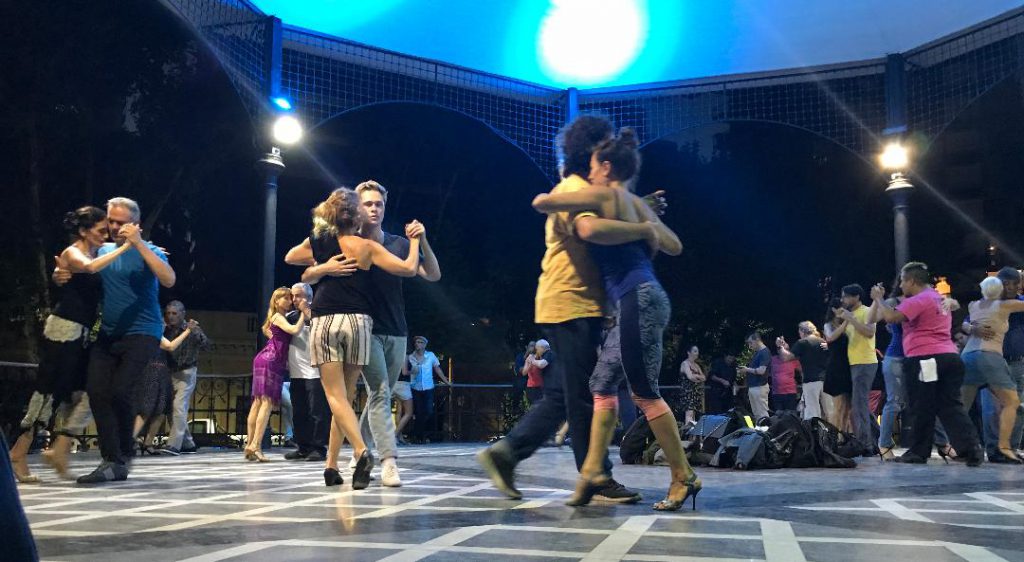
Tango at La Glorieta
A friend who had grown up in BA had given me a list of not-to-be-missed sites that included the cryptic “Tango at La Glorieta.” A few queries and a long taxi ride led us to a magical pavilion set in Barrancas de Belgrano park. On summer evenings dancers of all levels and ages, singly and in pairs, couple up while children play on the sidelines, dog walkers converse, lovers caress on benches, all to the haunting beat and the precise placement of the dancers’ nimble feet. We may have been the only tourists there, but we were entranced by what was undoubtedly the most genuine moment of the stay in this world-class city.
About the Author:
Gay Courter is a bestselling novelist (The Midwife, Code Ezra, Flowers in the Blood) and documentary filmmaker. She travels for both work and pleasure since her first around-the-world trip at age six.

Author, Gay Couter

